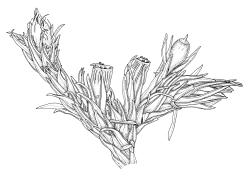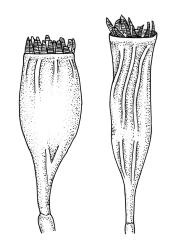- = Orthotrichum latorum R.Br.bis, Trans. & Proc. New Zealand Inst. 27: 431 (1895)
- = Orthotrichum reflexum R.Br.bis, Trans. & Proc. New Zealand Inst. 27: 431 (1895)
- = Orthotrichum praeperistomatum Venturi, Rev. Bryol. 23: 67 (1896)
- ≡ Orthotrichum pulvinatum var. praeperistomatum (Venturi) Sainsbury, Rev. Bryol. Lichénol., n.s. 21: 218 (1952)
- = Orthotrichum rupestriforme Venturi, Rev. Bryol. 23: 67 (1896)
Orthotrichum pulvinatum sensu Dixon 1926, p. 178; sensu Sainsbury 1955, p. 212.
Plants 15–45(–60) mm, in loose to dense tufts or mats, olive-green, yellow-brown or rarely ± grey and glaucous above, brown to black below. Stems often branched repeatedly (probably by both forking and innovation), with brown, smooth rhizoids below. Leaves erect-spreading when moist, appressed and almost straight when dry, ovate-lanceolate, (2.5–)3–4(–4.5) × 0.7–1.4 mm, often with 2 plicae near base, acute or sometimes acuminate, entire, strongly and sometimes broadly recurved from base to shortly below apex; mid and upper laminal cells isodiametric or oblong, usually rounded, incrassate, unistratose in N.Z. material (sometimes with bistratose patches outside N.Z.), (6.5–)10–17.5(–21) × 6.5–13(–14.5) µm, with 2–3 branched or unbranched papillae per cell; papillae of mid laminal cells variable in height, commonly to c. 9 µm in var. rupestre and to 18 µm or more in var. papillosum; basal laminal cells narrowly rectangular or rhomboidal, 35–77(–105) × (6.5–)10–18(–21) µm, with ± thick and nodose walls, with or without pores, often yellow or brown; cells of basal margins difficult to observe because of recurved margins, similar to upper laminal cells in several rows. Gemmae absent.
Gonioautoicous. Perigonia numerous on stems. Capsules emergent, ovoid to short cylindric, smooth or with 8 short and shallow furrows in upper part and slightly or not constricted below mouth when dry, not furrowed when moist, 1 per perichaetium; setae very short, c. 1 mm; exothecial cells slightly differentiated into strips in upper part of capsules, with several rows of rounded, thick-walled cells just below mouth; stomata superficial, variably distributed in capsule wall in N.Z. material, rarely surrounded by ring of short, radiating cells; operculum as per genus. Peristome single or double; exostome teeth 8, yellow-orange, mostly erect-spreading, occasionally ± recurved when dry, perforate along middle line or completely split to form 16 free teeth, their outer surface with dense or sparse ornamentation of single or compound papillae; preperistome usually ± well-developed, sometimes absent; endostome present or absent, when present with 8 short uniseriate segments, hyaline, smooth or finely granulated. Calyptra campanulate-mitrate, yellow with red-brown apex, plicate, slightly lobed at base, with numerous ± yellow hairs which are straight or curled, sometimes papillose, and usually exceeding the calyptra apex. Spores globose, 1-celled, 20–26 µm, ± roughly papillose, golden-brown.
| Category | Number |
|---|---|
| Indigenous (Endemic) | 1 |
| Indigenous (Non-endemic) | 1 |
| Total | 2 |
The robust habit and occurrence of this usually olive-green species growing on non-calcareous rock facilitate its recognition. The emergent capsules are often numerous (but only one per perichaetium) and of various ages on single stems; they have short furrows restricted to the upper part of the capsule and erect-spreading exostome teeth when dry. There is usually a well-developed preperistome (which restricts the movement of the teeth upon drying). The strongly recurved leaf margins also facilitate the recognition of this species, which, in N.Z., remains known only from the South I.
Orthotrichum rupestre var. rupestre and var. papillosum were regarded collectively by Dixon (1926, p. 178) as a N.Z. endemic, which he termed O. pulvinatum R.Br.bis. Dixon noted a close relationship between O. pulvinatum and the widespread and predominantly northern hemisphere O. rupestre. Sainsbury (1955, p. 214) also recognised O. pulvinatum as endemic and stopped just short of treating it as a synonym of O. rupestre Schwägr. Sainsbury, however, noted that Brotherus (1925, p. 17) reported O. rupestre from N.Z. While Scott & Stone (1976, p. 228) also commented on the close similarity of N.Z. material and O. rupestre, Lewinsky (1984) seems to have been the first author since Brotherus to unequivocally apply the name O. rupestre Schwägr. to N.Z. material. Because Lewinsky had exceptionally wide experience of the genus and of the species involved, her taxonomy is followed here.
In O. pulvinatum, Sainsbury (1955, p. 214) hesitantly recognised var. praeperistomatum Sainsbury, differentiated by possession of a preperistome. Lewinsky (1984, p. 402) argued against the recognition of that variety, noting that variability in preperistome development is common in numerous species allied to O. rupestre and "not a character [of] … any value on its own for separating subspecific taxa". However, Lewinsky (1984, pp. 385–387; 396) argued that the bimodal variability of the height of leaf papillae in N.Z. material justified the recognition of a South I. endemic variety, O. rupestre var. papillosum, which is accepted here.
Distribution, ecology, and synonymy as for varieties.






